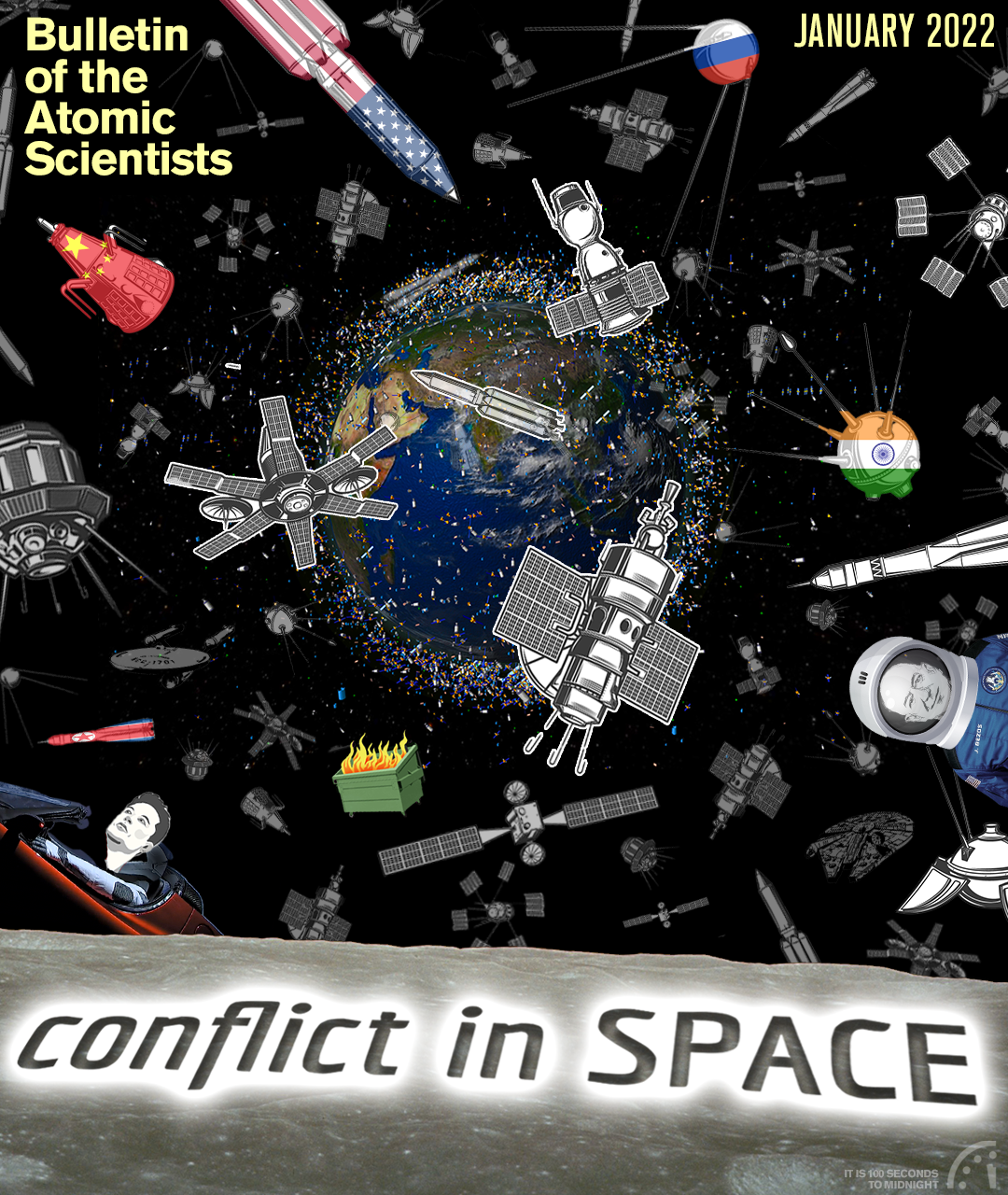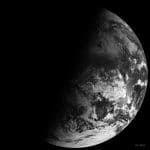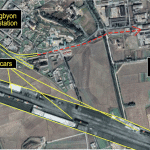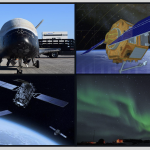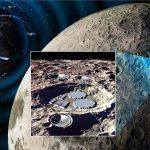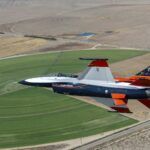Cis-lunar space and the security dilemma
By Michael Byers, Aaron Boley | January 17, 2022
Cis-lunar space and the security dilemma
By Michael Byers, Aaron Boley | January 17, 2022
Cis-lunar space is about to be rapidly developed, as a new space race emerges between China and the United States. Although the race is currently between civilian space agencies, all the conditions exist for a so-called “security dilemma,” whereby one country builds up its military because of imperfect information about the activities of a potential adversary (Booth and Wheeler 2008).
Cis-lunar space (Latin for “on this side of the moon”) is the spherical volume that extends outward from Earth’s geosynchronous region to encapsulate the moon’s orbit and its Lagrange points, or “L points”—defined as the locations where the combined gravitational acceleration due to the Earth and moon allow a small object, such as a spacecraft, to orbit the Earth at the same rate as the moon. Due to these unique features, L points are important for lunar development as locations where communications and monitoring equipment, refuelling depots, and even space stations could be maintained at relatively low energy-output. Even though cis-lunar space as a whole is large, extending to more than ten times the geosynchronous altitude, the usable regions near the five Lagrange points are more limited in volume. Consequently, they are highly desirable pieces of celestial real estate, so to speak. (See Figure 1.)
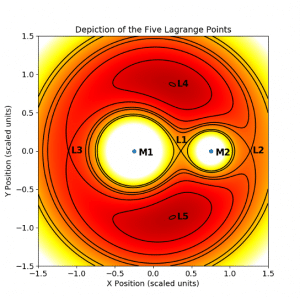
Due to the distances involved, Earth-based telescopes and radar are insufficient for monitoring spacecraft in cis-lunar space. Nor can they monitor the far side of the Moon. Instead, sensors for what is known as “space situational awareness,” or SSA—the tracking and providing of knowledge about the space environment and human activities in space—will have to be placed in cis-lunar space itself.
The Lagrange point known as L2 offers an ideal location to place a spacecraft for surveillance or as a communications relay. Satellites are not placed directly at L2 because it is an unstable equilibrium point, like a pencil placed on its tip. But they can maintain a “halo” orbit around L2 without expending much fuel. Since these orbits are physically large, satellites in L2 halo orbits are able to communicate with Earth at the same time that they observe operations on the far side of the moon. In 2019, China became the first country to use L2 in support of a lunar lander, called the Chang’e 4.
So far, only civilian science spacecraft have ventured into cis-lunar space. However, the US Air Force Research Laboratory recently announced plans to build two spacecraft to do just that. The first, known as the Cislunar Highway Patrol Satellite or CHPS, will be placed at one of the L points. From there, it will track other spacecraft in cis-lunar space and lunar orbits (Hitchens 2020A).
The second military venture will be the Defense Deep Space Sentinel or D2S2, described as a highly maneuverable spacecraft able to conduct “rendezvous/proximity operations” as well “space object removal and recovery, and other applications in defensive space operations” (Hitchens 2020B).
Arguably, any additional aid to space situational awareness from cis-lunar space would be a good thing, providing more information as to what other countries are doing—and what they are not. Yet such a role could just as easily be fulfilled by civilian spacecraft that could also engage in scientific studies, including detecting and tracking asteroids and comets for the purposes of planetary defense.
As for the Defense Deep Space Sentinel, there is nothing inherently wrong with space debris removal and recovery technology, provided it is used for peaceful purposes only. But such technology is inherently “dual use” and could be employed to interfere with other spacecraft. For this reason, efforts to clean up space debris, which is an important and daunting task, should be led by national space agencies. The Defense Deep Space Sentinel is also suspect because there is no current need for debris removal in cis-lunar space, and there is unlikely to be any such need for decades to come.
Perhaps just as important are the two closely questions of where, exactly, would the debris be moved to, and should any individual country be allowed to make these decisions on its own? Leaving space junk to drift uncontrolled in cis-lunar space, or redirecting derelict spacecraft so that they crash into the lunar surface—the two other most feasible options—are unsustainable practices. A third possibility, of sending debris into a heliocentric orbit, might seem like a better idea but would present its own challenges, including that the debris might come back to the Earth-moon system (Griggs 2020).
Meanwhile, the US Defense Advanced Research Projects Agency, or DARPA, has announced that it is starting up what it calls its Novel Orbital and Moon Manufacturing, Materials and Mass-efficient Design (NOM4D) program, which “seeks to pioneer technologies for adaptive, off-earth manufacturing to produce large space and lunar structures” (DARPA Press Release 2021). According to DARPA: “The NOM4D program will pioneer new materials and manufacturing technologies for construction on orbit and on the lunar surface …”. Although the program does not presently include an actual military base, the announcement on DARPA’s website is accompanied by an artist’s depiction that includes a sizeable building, a landing pad, and at least six vehicles—with the building and one of the vehicles sporting the letters DARPA on their sides. (See Figure 2.)
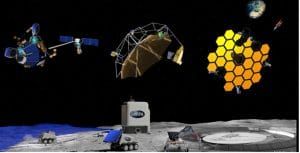
Even if DARPA is not planning to actually engage in surface operations, it is easy to imagine other countries reading the announcement as a statement of intent to militarize the moon. The NOM4D program will consequently create uncertainty with regards to US plans and therefore, quite possibly, security dilemmas for both China and Russia.
The US military’s plans for cis-lunar space are being justified as protection (Hitchens 2020C) for NASA’s Artemis Program, which will include a space station in lunar orbit as well as a permanent human presence on the surface. China is seen as the principal threat to the program (Zivitski 2020), even though it is unclear what would motivate that country to interfere with NASA’s activities.
Extracting resources from the moon for anything other than rock (for construction) and water (for survival and fuel) is unlikely to be economically viable, at least for some time. The remote location and extreme environment combine to make any activities extremely expensive. And while helium 3 and precious minerals do exist on the moon, their concentrations are so low that large-scale mining and processing would be required. All this suggests that China’s lunar program is focused on pursuing scientific knowledge and stoking national pride—just like the Apollo program of the United States in the 1960s.
US military leaders are also using the perceived threat from China as an argument for seeking to establish rules of lunar access and behavior from a position of strength. In August 2020, General Steve Butow, who leads the Pentagon’s Defense Innovation Unit, said: “Much of our law that we follow today is established on precedents. And one of the things we don’t want to do, is we don’t want to let our peer competitors and adversaries go out and establish the precedent of how things are gonna [sic] be done in the solar system, beginning with the moon” (Hitchens 2020D).
However, there is already an extensive body of international law that applies in cis-lunar space and on the moon, including the UN Charter and the Outer Space Treaty. Article IV of the latter categorically prohibits all military activities on the moon and other celestial bodies. Therefore, the NOM4D program is inconsistent with the United States’ legal commitments. US military leaders are thus not only taking steps that could create security dilemmas; they are challenging foundational treaties designed to promote peace and security in international affairs.
Other risks
The US military’s plans for cis-lunar space could also create serious risks outside of the security domain, including for the future of radio astronomy. Terrestrial (NRAO 2021) and satellite-borne (Feder 1996) signal contamination of radio observations limits the radio astronomy that can be done from Earth. Interference from Earth orbit is also growing, due to the construction of mega-constellations of communications satellites. The idea of placing radio observatories on the far side of the Moon has been around for a long time, with concepts in development (Bandyopadhyay 2020). The Breakthrough Listen project is particularly interested in using the Moon as a unique and unspoiled opportunity for conducting Search for Extra-Terrestrial Intelligence science (Michaud in press).
Spacecraft in lunar orbits, orbiting around L points, or stationed elsewhere in cis-lunar space, could cause radio interference for these observatories in bands that have already been lost to Earth-based facilities. Even a lunar surface-based communication network could cause substantial interference (Alexander 2020) unless designed with the protection of radio astronomy in mind.
Radio interference is a foreseeable issue that could be adequately mitigated if appropriate actions are taken. However, all lunar actors would have to respect radio quiet zones and limit the number of satellites as well as the portions of the spectrum and the directions of the beams they use. Having militaries racing to position their own spacecraft in cis-lunar space could complicate this necessarily cooperative exercise.
There are also potential risks that involve congestion and debris. Although cis-lunar space is very large, the locations of greatest usefulness are restricted in size and therefore have physical carrying limits, even if we do not yet know what they are.
Many of the orbits are unstable and therefore subject to uncontrolled self-cleaning, including the halo orbits about L points as well as many lunar orbits. But the few lunar orbits that are stable will therefore attract human activity, which could lead to congestion, collisions, and debris—creating operational hazards both in those orbits and on the lunar surface. Collisions or fragmentation events will create even more debris, as is well established from events in Earth orbit. Debris streams could even develop between lunar and Earth orbits. Challenges such as spacecraft disposal in the cis-lunar environment therefore need to be addressed in advance, with safe procedures being followed by all spacefaring countries. This situation calls for restraint and close international coordination, which competing militaries are rarely able to provide.
Possible solutions
Space situational awareness in cis-lunar space should be shared freely, as a public good that will help to prevent accidents. Eventually, some kind of mechanism will be needed for monitoring the use of L point and lunar orbits and possibly to assign “slots” to prevent congestion, as occurs in geosynchronous orbit already. International planning for this kind of coordination should begin today.
At the same time, the Biden Administration should terminate the CHPS, Defense Deep Space Sentinel, and NOM4D programs, or reassign them to NASA so as to avoid the potentially destabilizing militarization of cis-lunar space. It should also support the negotiation of a treaty prohibiting weapons in cis-lunar space, including dual use technologies operated by militaries.
Space has long been a focus for arms control, beginning with the 1963 Limited Test Ban Treaty that prohibited nuclear explosions in space. In 1967, the Outer Space Treaty banned all weapons of mass destruction from space and designated the moon as “exclusively for peaceful purposes”. Today, there is a similar opportunity to keep weapons out of cis-lunar space. The demarcation of Earth orbit and cis-lunar space provides a clear line upon which a demilitarization commitment could be based.
We can still develop the moon and its associated orbits. But as we have learned from decades of human activity in Earth orbit, developing space in a sustainable way requires foresight, planning, and cooperation. Space must be recognized as an environment that is worth preserving, and as one in which fast-paced alterations can have a myriad of unintended consequences. From avoiding security dilemmas to maintaining radio quiet zones to coordinating the use of orbital slots, in cis-lunar space, we still have the chance to get things right.
Acknowledgements
The authors are grateful for feedback on an early draft of this article from the participants in a space security workshop organized by the Outer Space Institute in May 2021.
References
Alexander, E. 2020. “A 4G network on the moon is bad news for radio astronomy.” October 23. The Conversation. https://theconversation.com/a-4g-network-on-the-moon-is-bad-news-for-radio-astronomy-148652
Bandyopadhyay, S. 2020. “Lunar Crater Radio Telescope (LCRT) on the Far-Side of the Moon.” April 7. NASA. https://www.nasa.gov/directorates/spacetech/niac/2020_Phase_I_Phase_II/lunar_crater_radio_telescope/
Booth, K, and Wheeler, N. 2008. The Security Dilemma: Fear, Cooperation and Trust in World Politics. London: Bloomsbury Publishing. https://www.macmillanihe.com/page/detail/The-Security-Dilemma/?K=9780333587454
DARPA. 2021. “Orbital Construction: DARPA Pursues Plan for Robust Manufacturing in Space.” Press release, DARPA Public Affairs. https://www.darpa.mil/news-events/2021-02-05
Feder, T. 1996. “Iridium Satellite System Poses Threat to Radio Astronomy.” November 1. Physics Today. 49, 11, 71 (1996) https://doi.org/10.1063/1.881550
Griggs, M. 2020. “Earth’s next mini-moon might be space junk from the 1960s.” October 12. The Verge. https://www.theverge.com/2020/10/12/21512725/mini-moon-space-junk-nasa
Hitchens, T. 2020A. “AFRL Satellite To Track Up To The Moon; Space Force-NASA Tout Cooperation.” September 21. Breaking Defense. https://breakingdefense.com/2020/09/afrl-satellite-to-track-up-to-the-moon-space-force-nasa-tout-cooperation/
Hitchens, T. 2020B. “Space Force, AFRL To Demo Mobile Lunar Spy Sat.” November 30. Breaking Defense. https://breakingdefense.com/2020/11/space-force-afrl-to-demo-mobile-lunar-spy-sat/
Hitchens, T. 2020C. “Space Force-NASA Accord Highlights Cooperation Beyond Earth Orbit.” September 22. Breaking Defense. https://breakingdefense.com/2020/09/space-force-nasa-accord-highlights-cooperation-beyond-earth-orbit/
Hitchens, T. 2020D. “Industry Says ‘Meh’ To DoD Cislunar Space Push.” August 28. Breaking Defense. https://breakingdefense.com/2020/08/industry-says-meh-to-dod-cislunar-space-push/
Michaud, E. No date, in press. “Overview—Lunar Opportunities for SETI.” Breakthrough Listen/Berkeley SETI. https://seti.berkeley.edu/lunarseti/
NRAO, 2021. “Radio Frequency Interference.” National Radio Astronomy Observatory. https://public.nrao.edu/telescopes/radio-frequency-interference/
Zivitski, L. 2020. “China wants to dominate space, and the US must take countermeasures.” June 23. Defense News. https://www.defensenews.com/opinion/commentary/2020/06/23/china-wants-to-dominate-space-and-the-us-must-take-countermeasures/
Together, we make the world safer.
The Bulletin elevates expert voices above the noise. But as an independent nonprofit organization, our operations depend on the support of readers like you. Help us continue to deliver quality journalism that holds leaders accountable. Your support of our work at any level is important. In return, we promise our coverage will be understandable, influential, vigilant, solution-oriented, and fair-minded. Together we can make a difference.
Keywords: Lagrange points, cis-lunar, de-militarization, lunar development, moon, orbits, space
Topics: Disruptive Technologies


